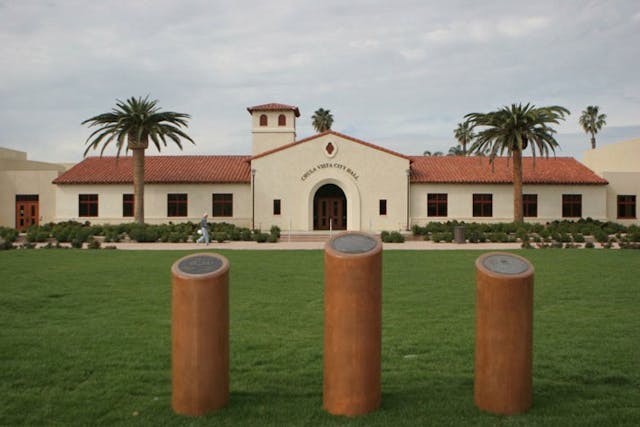Brown-skin religious icon revered by millions
They say that if you tell a mejicano there is no God, he may shrug his shoulders and go about his way.
God forbid you tell him that the Virgen de Guadalupe was merely a Spanish story made-up by los conquistadores to speed-up Catholicism in the New World. Ah, good luck with that.
Some of the leading religion skeptics insist that the Virgin of Guadalupe is essentially Mexico’s version of the Shroud of Turin; that is, they are parts of fabric, hundreds of years old, on which appears an image. Believers swear that both images are miraculous, thus they have become some of the Catholic Church’s most sacred objects.
And there all comparisons cease, for La Guadalupana, as many call her, brings millions to her Basilica, on Tepeyac Hill, near Mexico City. Her drawing power is second only to the Vatican itself. She has become such a powerful icon that anywhere you visit in Mexico or the U.S. Southwest you’re sure to find a reproduction of the image. From personal altars in barrio homes to a lowrider’s trunk or a pinto’s tattoo, the Lady is to be seen everywhere.
Simply put, She is The Most Holy Virgin Mary, Our Lady of Guadalupe, Queen of Mexico, Empress of the Americas, La Virgencita and among the indigenous, Tonantzin. Remember that about this time in the turbulent history of Latin America, Job One was to turn “the savages” into good Catholics, by whatever means necessary.
“In 1531, the Spanish had been occupying Mexico for about ten years,” said Northern California Catholic Deacon Herman Varela. “ An indigenous peasant, Juan Diego, was walking in what’s now Mexico City when he saw what he thought to be a young girl on a hill, and she identified herself as the Virgin Mary, and then asked him to build her a church on that spot.”
That’s pretty much what millions upon millions of Catholics have heard throughout their lives in several languages on December 12, the day set aside by the Church to commemorate one of history’s greatest religious acts – the apparition of the Mother of Jesus Christ to an indio mejicano.
“Juan Diego raced to the Archbishop of Mexico, Juan de Zumárraga, to inform him of what had happened, but the Bishop was skeptical and told Juan Diego to return and ask her to prove her identity with a miracle,” said Varela. “ Poor Juan Diego did return, and thankfully encountered the apparition again, then La Guadalupana told him to pick some flowers to present to the Bishop as proof of his encounter with Her.”
Keep in mind that it was winter and no flowers should have been in bloom, however, Juan Diego found an abundance of flowers of a type he’d never seen before.
“The Virgin Mary bundled the flowers into Juan Diego’s cloak, woven from common cactus fiber and called a tilma, said Varela. “ When Juan Diego presented the tilma to Zumárraga, the flowers fell out.”
Varela repeats this story every year as he goes about visiting migrant camps and small parishes too far from any large town.
“Castilian roses!” Varela said the Bishop exclaimed. “Such a type of rose was not to be found in Mexico, but far better for Juan Diego, the tilma was now imprinted with an image of the Virgin herself!”
It is important to note that Cortés, who overthrew the Aztec Empire, grew up revering Spain’s own Lady of Guadalupe. His Guadalupana was a darker version of the Virgin Mary. This particular Virgen is credited with miraculously helping to expel the Moors (who were Black) from Spain. That in itself is interesting-a dark image helping defeat a dark army!
Ancient records indicate that Cortés brought reproductions of this European version of the Virgen Mary with him to the New World.The image, with dark skin resembled the Aztecs, thus becoming a fitting icon for his Spanish missionaries to usher the natives into Catholicism.
The Virgin of Guadalupe is the symbolic mother of mejicanos and their descendants. Everywhere. She personifies a peoples identity, history, culture and language. But She is more than an image that many interpret to be a history lesson. Notice her attire? It’s a reference to the geography of Mexico and to the Aztec/Mexica deities while the symbols also reveal part of the message of the Virgin to Juan Diego.
Those who interpret such ingenious symbolism and cultural motifs have had a field day. For example, we are told that the mantle is covered with stars that reflect the eras of a civilization and a relationship to Ometeotl the god of all duality.
The dress or robe is red with symbolic “writings” that tell a story to the Nahuatl people and the belt worn by the Virgin is a maternity band, explaining expectant birth or new expectations and She is stepping on the moon, indicating greater importance in relation to the sister of the sun, Coyolxauhqui while the golden rays of the sun surrounding Her point to the presence of the sun god, Quetzalcoatl.
Quite a story. One that is waiting to be told and retold by both nonbelievers and those of us who venerate La Virgen de Guadalupe.






